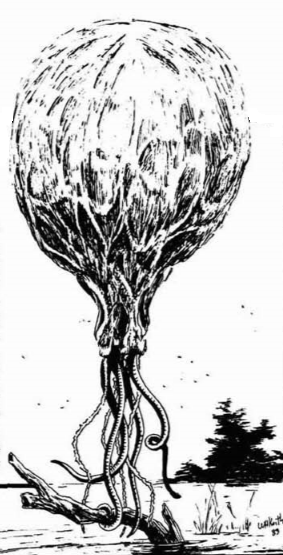Difference between revisions of "Luugiir"
(Fix JTAS ludography citations) |
|||
| Line 42: | Line 42: | ||
== Life Cycle & Reproduction == | == Life Cycle & Reproduction == | ||
| − | Luugiir are | + | Luugiir are [[wikipedia:Gonochorism|gonochoric]] (individuals are either male or female) and oviparous. The mating flight of a pair of Luugiirs is a spectacle of rare grace and beauty. The animals usually form one lasting pair bond, and hatch two young Luugiirs each year. |
== Diet & Trophics == | == Diet & Trophics == | ||
Revision as of 11:58, 29 August 2021
| Luugiir | |
|---|---|
 {{{caption}}} | |
| Base Information | |
| Classification | Herbivore/filter & Photosynthetic Autotroph |
| Terrain | Terrestrial |
| Locomotion | Floater / Flyer |
| Size | 1.5m / 3.0kg |
| Speed | Unknown |
| Strength | Unknown |
| Social Structure | Unknown |
| Weapons | Stingers |
| Armor | None |
| Source | |
| Homeworld | Unknown |
| Multi-world | Yes |
| Canon | No |
| Extinct | Extant |
| Reference | Journal of the Travellers Aid Society No. 18 |
(Aeromedusae Globosus Domesticus) Luugiirs earn their name/s from their highly unusual nature. Through a mechanism which continues to fascinate xenobiologists right down to the present day, these animals generate and store hydrogen gas in large bladders, turning them into organic balloons.
Also known by a number of Anglic names - blimp, balloon-head, goodyear, drifter, floater, and gasbag, among others - the Luugiir is found on many worlds throughout the Third Imperium and adjacent regions.
Its original homeworld is no longer known, though it is probably one of the low-gravity, dense atmosphere worlds included in the earliest Vilani interstellar sphere of influence.
Physiology & Ecology
The Luugiir is invertebrate-like, resembling in some respects a Terran Jellyfish; its position on the evolutionary scale, however, is much superior, and it has been surmised that the animal's home world never developed vertebrate-like forms.
Despite their size (a Luugiir usually ranges from 0.75 to 1.5 meters in diameter), floaters are light, since most of their body is the gas bag and associated systems. The body proper, containing the animal's vital organs, is suspended below the gas bag, where the eight tentacles come together. Total body weight rarely exceeds 3.0 kilograms, although larger animals have been reported.
Organic Electrolysis
The Luugiir spends a large portion of each day resting in or floating just above small pools of water, lakes, streams, and the like. The creature takes in water, which is broken down into component hydrogen and oxygen. The hydrogen is stored in the creatures gasbag, giving it buoyancy; photoreceptive surfaces on the upper surface of the animal absorb energy needed for this organic electrolysis process from sunlight.
Organic Maneauver Jet
The Luugiir also has a limited sort of "maneuvering jet", air from its lungs can be expelled under pressure to give it some control over its direction. (For the most part, the floater just drifts with the wind.) Four grasping tentacles "tether" the beast on convenient plants or rocks until it is ready to let go.
Domesticated Luugiir are sometimes fitted with a collar attached to a long thin cable, to keep them from being blown away. Others are provided with a network of cables suspended from poles, to which they anchor themselves during high winds.
Natural Defenses
Luugiirs have a natural defense against predators, in the form of four specialized "stinger" tentacles. These inject a fast-acting poison which inhibits the involuntary muscle action of most animals. The poison (venom) strongly affects humans causes respiratory failure, seizures, and death within two to twelve minutes.
- Domesticated Luugiirs, however, usually have their poison sacs removed, in the same way as the scent sacs of a pet Terran Skunk can be rendered ineffective.
Life Cycle & Reproduction
Luugiir are gonochoric (individuals are either male or female) and oviparous. The mating flight of a pair of Luugiirs is a spectacle of rare grace and beauty. The animals usually form one lasting pair bond, and hatch two young Luugiirs each year.
Diet & Trophics
The Luugiir's main source of food comes from small flying creatures. A filter-feeder, the Luugir drifts through clouds of such animals, consuming them. Domesticated animals will eat almost anything released into the air, and are easy to care for.
History & Background (Dossier)
Some Luugiirs have returned to a wild state, and can be encountered on many worlds where the atmosphere is breathable and the competition from more efficient aerial forms is not severe.
Training
Luugiirs can be trained with patience and (in the case of those with intact stingers) caution. In certain rare cases, floaters have been trained to attack on command, and are used by assassins or guardians of valuable property.
Pets
Domesticated by Vilani colonists sometime early in the First Imperium, the animal became a common and popular pet, and was spread throughout Vilani space.
- Luugiirs are approximately as intelligent as a Terrestrial housecat, but exhibit the loyalty, affection, and faithfulness of a dog (An early Solomani account of the animals refers to them as a "sort of aerial airedale"). They are popular as pets; their excellent senses and characteristic moaning warning cry make them fine watchdogs.
Travellers' Aid Society Advisory
They are mildly dangerous, because of their stingers, but can be avoided by exercising a modicum of caution.
References & Contributors
- Loren Wiseman. "Bestiary:Luugiir." Journal of the Travellers' Aid Society 18 (1983): 28.
- Loren Wiseman. Journal of the Travellers' Aid Society 01 (Game Designers Workshop, 1979), 14-15.